India’s spiritual landscape is vast and diverse, but some temples stand out not just for their sanctity, but for their astonishing geographical settings. These are places where the natural world and the divine seem inseparable - shrines perched on Himalayan ridges, sanctums that sink under the tide, and temples hidden so deeply in forests that they survived unseen for centuries.
Below is an expanded, in-depth look at five of India’s most unique temple locations, enriched with history, insights, rituals, geography, and reasons to visit.
1. Tungnath Temple, Uttarakhand
The Highest Shiva Temple on Earth (3,680 m)
Why This Location Is Extraordinary
Tungnath sits high above the clouds in the Garhwal Himalayas. The temple is located on a ridge overlooking some of India’s grandest peaks such as Chaukhamba, Neelkanth, and Kedarnath. Because of its elevation, the air is thin, the silence is profound, and the temple feels suspended between earth and sky.
Mythology and Historical Background
Tungnath is one of the five Panch Kedar temples. According to the Mahabharata, the Pandavas sought Shiva’s forgiveness after the Kurukshetra war. Shiva avoided them by taking the form of a bull and diving underground. At Tungnath, the bull’s arms surfaced, and a temple was built to mark this divine emergence.
Scholars date the temple to around 1,000 years old, likely constructed under the Katyuri or Pandava lineage.
Rituals and Pujas
Rudrabhishek with ice-cold Himalayan spring water
Panchamrit puja by local Brahmins
Daily aarti in the small stone sanctum
In winter, when heavy snow blocks the region, the deity is shifted to Mukunath village
The Journey
Trek distance: Around 3.5 km from Chopta
Difficulty: Moderate, but altitude requires pace control
Best time to visit: April to November
Avoid winter due to snow, ice, and closed temple doors
Why You Should Visit
Visitors often describe Tungnath as one of the most peaceful places on earth. The views are majestic, the spiritual energy is intense, and the sense of accomplishment after the trek adds to its sanctity. Sunrise from Tungnath is considered one of the most spectacular in the Himalayas.
2. Umananda Temple, Assam
A Temple on the World’s Smallest Inhabited River Island
Why This Location Is Extraordinary
Umananda is located on Peacock Island in the middle of the mighty Brahmaputra River. The island is small enough to walk around in minutes, yet it contains centuries of devotion and folklore. Surrounded by the wide Brahmaputra, the temple appears almost like a floating shrine.
Mythology and Cultural Significance
The Kalika Purana recounts that Shiva created the hill on the island for meditation. When Kamadeva disturbed him, Shiva’s anger reduced Kamadeva to ashes, giving rise to the name Bhasmachal. Over time, the island and its temple became important parts of Assam’s Shaivite traditions.
Rituals and Festivals
Shivratri draws large crowds from across Assam
Traditional Assamese style worship
Offerings include milk, flowers, water, and bel leaves
Evening aarti on the river-facing steps creates a serene ambiance
How to Reach
Ferry rides operate from Guwahati’s Kachari Ghat (approximately 10 minutes)
A cable car also connects the city to the island, offering panoramic views
Why You Should Visit
Umananda offers river-side spirituality, scenic views, and a peaceful island environment. It is ideal for those who love combining culture, nature, and simple but profound experiences.
3. Amarnath Cave Temple, Jammu and Kashmir
Home of the Naturally Formed Ice Shivling
Why This Location Is Extraordinary
Amarnath is one of the most revered pilgrimages in India. The cave sits at an altitude of around 3,888 m, surrounded by snow-covered mountains. Inside the cave, a naturally formed ice shivling appears each year as water droplets freeze in layers. This natural formation is considered a divine manifestation of Shiva as Baba Barfani.
Mythology of the Amar Katha
Legend says Shiva narrated the secret of immortality to Parvati inside this cave. To ensure no living being overheard the sacred story, he left behind all his symbols and companions, including Nandi and even the Moon, before stepping into the cave.
The Amarnath Yatra
There are two main routes:
Pahalgam route - longer, traditional, scenic
Baltal route - shorter but steeper, suitable for fit pilgrims
The trek passes through glaciers, mountain passes, narrow pathways, and breathtaking valleys. Weather can change suddenly, making the yatra both challenging and spiritually uplifting.
Rituals
Darshan of the ice shivling
Offering of prasad distributed near the cave
Continuous chanting of “Bum Bum Bhole” by pilgrims and sadhus
Why You Should Visit
Amarnath is more than a journey; it is a test of faith, resilience, and devotion. The dramatic Himalayan landscape combined with the spiritual importance of the cave makes this yatra one of the most transformative experiences for Hindu devotees.
4. Dholkal Ganesh Temple, Chhattisgarh
A 1,100-Year-Old Ganesha Hidden Deep in the Forest
Why This Location Is Extraordinary
Located atop a 3,000-foot hill in Dantewada, this site remained unknown to the modern world until 2012. It is not a temple structure but a solitary 1,100-year-old stone idol of Lord Ganesha placed on a natural rock platform high above dense forests.
Historical Context
Historians link the idol to the Naga kings who ruled the region around the 9th to 10th century. The carving style matches ancient tribal-influenced Ganesha sculptures of central India.
The idol mysteriously toppled off the cliff in 2017 but was later restored using a helicopter operation.
The Trek
A forest trail passing through tribal settlements
Moderate difficulty, requiring around 2 to 3 hours
Best during early morning or cooler months
The serene environment and lack of commercial activity make the journey meditative.
Ritual Practices
Local tribes perform puja with turmeric, vermilion, and flowers
Special rituals during Ganesh Chaturthi
Priests often narrate tribal legends and tales associated with the idol
Why You Should Visit
Dholkal offers a rare combination of archaeology, mystery, spirituality, and natural beauty. It is ideal for those seeking offbeat, raw, and unexplored pilgrimage sites far from city crowds.
5. Stambheshwar Mahadev Temple, Gujarat
The Temple That Disappears Under High Tide
Why This Location Is Extraordinary
Located in Kavi Kamboi near Vadodara, Stambheshwar Mahadev is one of the country’s most unique tidal temples. During low tide, the shrine is fully accessible. But when the tide rises, seawater gradually engulfs the shivling and the entire temple structure. The appearance and disappearance of the temple symbolizes cycles of creation and dissolution.
Mythological Links
The temple is said to have been built by the sons of Sage Kashyapa after Shiva destroyed the demon Tarkasura. It stands as a reminder of Shiva’s power and protection.
Rituals and Experiences
Devotees schedule darshan according to tide timings
Aarti performed during receding tide is a major attraction
The sight of waves gently covering the shrine is deeply symbolic and meditative
Travel Details
Best visited in early morning or late afternoon low tide
Tide timings are available locally and online
The coastal landscape is serene and largely untouched
Why You Should Visit
This is one of the rare places where nature itself performs a daily ritual. Watching the sea reclaim the temple at high tide is a spiritual and visual experience unlike any other in India.
These five temples demonstrate the extraordinary way India blends nature with spirituality. From plunging Himalayan valleys to floating river islands, from secret forest hilltops to tidal shorelines, each of these sacred places offers more than a visit - they offer a life-changing experience.
Whether you are a pilgrim, a traveler, a historian, or a seeker of beauty, these temples promise a journey into India’s soul.









